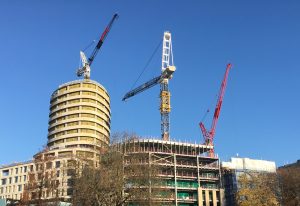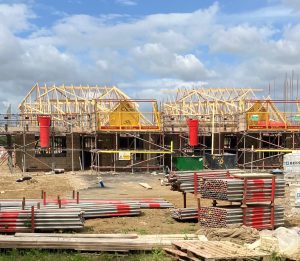It’s all in the data
The UK is facing a convergence of long-standing structural problems and urgent environmental, social, and political pressures. Population growth, infrastructure decay, a fragmented construction industry and an ageing housing stock are forcing overdue decisions across government and industry. Nowhere is this more visible than in the drive for safer, more sustainable buildings.
Mike Rigby, CEO of MRA Research examines the data to see what the numbers are telling us about the state of the construction industry and the challenges it is currently being faced with.
The Economy
Firstly, a look at the population stats.
The UK population was 60m in 2005, and is forecast to reach 70m by 2026, +17% up in 20 years. Growth is being driven by net migration and demographics – many immigrants are of child rearing age. It’s grown faster over the last 20 years and is set to grow much faster over the next decade than in most European countries.
Since 1990 governments have struggled with recurring financial and political crises – falling out of the ERM, the financial crisis of 2008/9, austerity, Brexit, Covid and the funding to shut the economy, and the financial shock of Prime Minister Truss. Governments have generally ducked long-term challenges eg climate change, an ageing infrastructure, and a growing but ageing population, but it’s become harder to avoid fixing those problems.
Now it looks like we have run out of road: rail is being renationalized, roads are potholed, no water reservoirs have been built in 30 years and sewage spills into our rivers and coastline. The national grid is near capacity, the NHS is in semi-permanent crisis as it faces a capacity, productivity and a welfare/social care crisis, and too few houses are being built to meet UK housing needs.
Climate change is ratcheting up the pressure. The numbers suggest Britain is doing well at driving down CO2 emissions with wind and solar, but some gains are achieved by exporting emissions to other countries.
The Construction Market
 In the UK, construction accounts for 7-8% of GDP and 10% of jobs.
In the UK, construction accounts for 7-8% of GDP and 10% of jobs.
It’s big but it struggles to get its voice heard and its points understood, in comparison with simpler, smaller industries such as automotive, aerospace, retail, and energy. In those industries a few large companies, and a few large associations, speak for their market and explain the trends and issues.
Construction is larger than some of the industries above combined, and it has many large companies, but it’s fragmented, complicated with thousands of voices speaking for thousands of markets, so it’s difficult for the Government, the media and public to understand and get to grips with the issues. In other countries, construction has done a better job of coming together to speak with one voice, so it is heard more clearly.
This fragmentation also makes it hard for construction to change and adopt best practice and innovations. Getting your products specified is the first step and successful companies guard their specifications all the way down to installation to make sure cheaper ‘equivalents’ are not substituted along the way.
UK Housing
There are 29.9 million dwellings in the UK, with 25 million dwellings in England, 1.5 million in Wales, 2.67 million in Scotland, and 822,083 in Northern Ireland.
 Seventy-eight percent (19.3m) households live in a house or bungalow, 22% (5.4m) in a flat or maisonette.
Seventy-eight percent (19.3m) households live in a house or bungalow, 22% (5.4m) in a flat or maisonette.
In England, around 65% own their own home. Fifty-two percent own their property outright.
In London less than half of residents (47%) are homeowners, the only region where most are renters.
The UK has the oldest housing stock in Europe: 38% of homes were built before 1946 ahead of Belgium 37%, Denmark 34%, and France 29%. Over a quarter live in Victorian homes.
The UK spends more on housing than in almost any other developed country and gets the least value from it. The UK has some of the oldest, smallest, inconveniently located and worst quality housing in the developed world and pays the most for it.
Specification
The Grenfell Tower fire put construction centre-stage. Eight years after 72 people died in the fire, the Hackitt enquiry into what went wrong and the Building Safety Act and Fire Safety legislation, put non-combustibility as the default product feature.
Seven firms have been barred by the Government from public contracts, including two insulation companies, Kingspan and Celotex, for attitudes and behaviours that shocked the nation.
 In common with many major disasters, there was no single cause, but a catalogue of mishaps, errors, and poor practice. Reading the Grenfell inquiry findings, everything that could go wrong did go wrong and everyone involved – Government, testing houses, product manufacturers, the fire service, specifiers, contractors, installers, and landlords – bore some of the blame.
In common with many major disasters, there was no single cause, but a catalogue of mishaps, errors, and poor practice. Reading the Grenfell inquiry findings, everything that could go wrong did go wrong and everyone involved – Government, testing houses, product manufacturers, the fire service, specifiers, contractors, installers, and landlords – bore some of the blame.
The enquiry highlighted examples of bad practice at every level among organisations, including government and ambiguity in regulations, lack of checking and enforcement of specifications and installation, and a lack of overall control and oversight.
One result, revealed in MRA Research’s research, was specifiers being reluctant post-Grenfell to put their name on their specifications, instead sharing responsibility with groups or committees. They were unwilling to put their name on specifications when they had little control over subsequent changes.
Marketing practice, which was accused of being less than clear about claims and product performance, has been tightened up. MRA Research was commissioned by the CPA (one of the Hackitt Inquiry recommendations) to conduct the industry consultation, and research views of the new Code for Construction Product Information. The Construction Product Information Ltd (CPI) is responsible for managing the code.
A Huge Insulation Market?
Climate change is ratcheting up the pressure. The numbers suggest Britain is doing well at driving down CO2 emissions with wind and solar, but some gains are achieved by exporting emissions to other countries.
Significant effort has gone into achieving zero carbon in newbuild homes but only raising the performance of the existing housing stock, which is among the oldest and poorest in Europe, will make a significant difference.
The UK’s population size and growth, and the scale of the improvement needed to bring the housing stock up to an acceptable standard and stop wasting money and emissions mean the size of the addressable market for insulation in the UK is massive.
If all UK homes are to reach the government’s benchmark 2030 target energy efficiency standard (an EPC energy performance certificate C rating), it will require retrofitting millions of buildings with better insulation and double-glazing costing up to £118bn over five years at an average value per home of £11,120. Even a lower cost per home of £6,220 over five years equates to £65.4bn.
As of 2030, private landlords will be required to meet EPC C or equivalent in their properties, up from a current E rating.
Soon after Grenfell, Knauf Insulation joined Rockwool in promoting non-combustibility. Until then there seemed to be a gentleman’s agreement among insulation manufacturers (apart from Rockwool) to go light on fire. After Grenfell, when videos of PIR/PUR were shown going up in flames and the media picked up on one of the phrases used in the Inquiry, “clad with insulation like petrol”, mineral and glass wool manufacturers began more overtly to promote non-combustibility and the full balance of product properties: fire, sound, energy saving etc.
Twelve years ago, the government dropped the Green Deal, the original attempt to retrofit the UK housing stock to improve energy performance. They asked consultants, retailers and others eg B&Q, but were selective in who they listened to in the industry. The Government was not investing much in the Green Deal aiming instead to leverage its investment to get the industry to invest heavily. Some large companies invested in extra capacity and customer training to meet the expected demand. But the Green Deal never got off the ground and many companies felt let down.
To summarise..
The UK’s economic and structural challenges are complex, interlinked, and increasingly unavoidable. Construction and housing—central to resolving crises in infrastructure, climate, and energy—require coordinated, long-term thinking that has often been absent. Grenfell was a tragic wake-up call, and post-disaster reforms show how safety and sustainability can no longer be secondary considerations. There is a lot to do.
